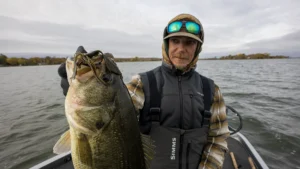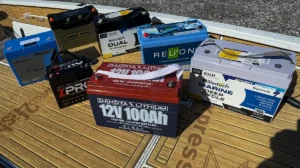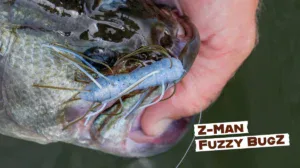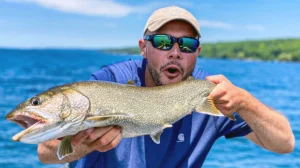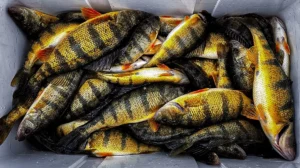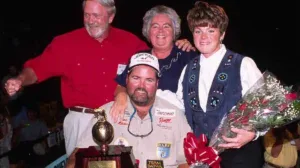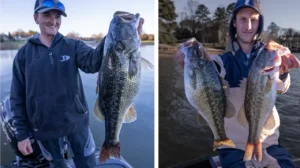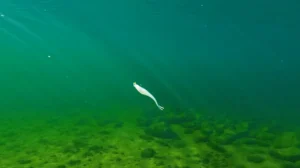Don’t let the nasty, cold weather this winter keep you off the water. Although coldwater bass have a well-deserved reputation as being obstinate and tough to catch, fishing with deep crankbaits can drastically increase your success.
Elite Series pro and 2008 Bassmaster Classic champion Alton Jones does some of his best work when the bass begin relating to deep water. In fact, he’s caught well over 60 bass exceeding the 10-pound mark with a deep crankbait. Not too shabby, right?
According to him, there are some important aspects to understand in order to ensure your wintertime deep cranking is up to par.
Why throw a deep crankbait?
Yes, it’s true—coldwater bass may not go to great lengths to actively pursue their prey. It’s cold, their metabolism is slow and they’re going to exert as little energy as possible. It’s important to realize, however, that they still have to eat and a deep crankbait can entice these inactive bass to feed out of pure instinct.
“A lot of times in the winter, bass are feeding on shad and crawfish,†Jones said. “With small color changes, deep crankbaits are outstanding imitators of both types of forage. Even if a bass isn’t hungry, a big crankbait swimming in front of their face can trigger their predatory instinct to attack.â€
Although you can certainly catch winter bass in shallow water, Jones targets deep water to take advantage of its “insulation factorâ€. When a cold snap hits an area, bass will make a concerted effort to find the warmest and most stable water.
“In order to escape declining water temperatures, bass will move deeper in the water column where the water is more insulated,†Jones said. “When your area gets a cold spell, the very first water to cool will be the shallower depths closer to the surface. In turn, the deeper water is much more stable and insulates the bass from the immediate effects of the cold weather. It’s just like having a thicker wall on an ice chest.â€
Know when to use it
When deciding to throw a deep crankbait, Jones closely monitors the current weather conditions. If it looks like a good day to be throwing a shallow spinnerbait—in warmer weather, of course— he’ll have a big crankbait nearby.
Jones’ favorite crankbait is a Bomber Fat Free Shad. He’s caught more giant bass with it than any other crankbait. When the bass are feeding on shad, he primarily uses the Dance’s Citrus Shad and Dance’s Pearl White colors. If they’re eating crawfish, he suggests the Texas Red Sparkle color.
“I’m always going to lean more towards deep cranking when there is some sort of cloud cover present,†Jones said. “It can be partly cloudy, overcast or rainy, but sunny conditions aren’t ideal. I’m also going to look for some sort of surface disturbance, whether it’s a slight ripple on the water or a strong wing. As long as it’s not a calm, clear day, you should catch some fish.â€
If you’re researching winter bass fishing, it’s not uncommon to hear tales of spinning rods, light line and finesse baits. Jones prefers to use a beefier, reaction-type presentation in cold weather for several reasons.
“If the conditions line up, I’m going to start the day deep cranking until the fish tell me otherwise,†Jones said. “It allows me to be much more efficient and effective. I can show it to more fish, cover large areas quickly and I really believe bigger bass are more susceptible to reaction lures. When I look at the bass I’ve caught over 10 pounds, I’ve probably caught 70 percent of them on a deep crankbait—there has to be something to that.
Never underestimate the power of a long cast
Long casts will certainly help your cause with many bass fishing techniques, but casting distance is especially imperative when using a deep crankbait. Not only will a long cast help you avoid spooking the bass, but it will also get the crankbait in the most productive section of the water column.
“The winter months are an outstanding time of year to target giant bass,†Jones said. “When you’re targeting these big ones, your odds will skyrocket if you can put more distance between the two of you—the close you get to ‘em, the more aware they are. It also helps you get the bait to its proper operating depth easier. If a bass is 40 feet away, your cast needs to be 60 feet because the first 20 feet of your retrieve will be spent getting the lure down to the strike zone.â€
Recognize high-percentage areas
Contrary to popular belief, the best wintertime areas to deep crank are not the same areas you would target in the summer. Jones looks for three primary areas, all of which share one common denominator.
- Ditches—“I always want to find some sort of a ditch that relates to a creek channel,†Jones said. “It doesn’t have to be a major river channel. These creek channel ditches are the pathways that bass naturally follow because they give them quick access to deep water at all times. If you’re new to deep cranking, start by finding the nearest bridge and fish the openings and pilings where the bass winter. Wherever that road crosses the creek, there will probably be a large ditch in the creek channel.â€
- Get ’em fired up: When you catch your first fish in a certain area, expect more bites to follow. Jones will often fight the first fish for an extended period to let it swim through the school– this sparks the bass’ innate predatory instincts and will result in more bites.
- Bluffs—“You can also catch some really big bass by deep cranking bluff walls and the ends of bluffs that transition into deeper water,†Jones said. “A bluff is simply an area in which the creek channel swings close to the bank and it’s all about the creek channels.â€
- Tapering points—“If you can find a flat, gradually tapering point protruding into a creek channel, you have a great chance to catch them with a deep crankbait,†Jones said. “The bass will position on the edge of the taper where it begins to drop more abruptly. I’m going to be targeting points where the top of the drop sits in 10 to 15 feet of water so it’s easier to probe with a crankbait.â€
Needless to say, creek channels play an integral role in Jones’ wintertime deep cranking strategy. There are wintering holes on every fishery and, according to him, they’re always located near the deepest part of a creek channel.
“A lot of times you can find these wintering holes where the current cuts into the creek channel and creates a hole,†Jones said. “In a reservoir, these holes may be in 20 feet of water, but I’m going to fish the drop-offs closest to those holes. If you idle under a bridge, examine your graph and take mental notes, it will be much easier to find a similar area along the same creek channel.â€
Fine-tune your casting angles

There are times of the year in which your crankbait casting angles aren’t a primary concern, but this isn’t one of them. Casting angles are a big key to your deep cranking success and Jones employs a very methodical approach.
“I always want to cast my crankbait up-current and retrieve it down-current because bass are notorious for positioning nose-first into any available current,†Jones said. “Let’s say the fish are on the side of a point closest to the boat—the crankbait will dive down into the point and go right over top of them. If you position on the other side of the point, it’s going to dive right down to the fish.â€
Regardless of the situation, Jones makes it a point to try every possible angle before moving on. This experimentation can often lead to hot action, cast after cast.
“It’s not uncommon to catch a bass casting at the wrong angle,†Jones said. “If you don’t catch another one, that one bass did something very important—it clued you in to the school’s location. If you move around and try different angles, you can fine-tune your approach and figure out how to catch all of them.â€
3 deep crankbait retrieves to cover your bases
Whether you’re fishing a shallow or deep-running crankbait, your retrieve is critical. The bass’ preference can change daily, so similar to your casting angles, experimentation should always be considered.
- Variable—“My first few cranks on a long cast are going to be pretty quick in order to get the crankbait down to the fish,†Jones said. “Once I get it down to its maximum depth, I’m going to use an erratic retrieve. I’ll burn it, twitch it, pop it and pause it—anything to imitate a fleeing or injured baitfish.â€
- They gotta see it: Jones doesn’t prefer deep cranking in heavily stained water. He needs at least 18 inches of visibility and the action gets even better with two to three feet of visibility.
- Burning and stopping—“This is an extremely effective retrieve,†Jones said. “I’m going to wind it as fast as I possibly can and stop it abruptly. When you burn a crankbait through a school, even an inactive bass is apt to attack it because it looks like it’s running from something. Bass are competitive and don’t want another bass to get a meal before they do. If you stop the crankbait about six times throughout the retrieve, you’ll get some unreal reaction strikes.â€
- Slow crawl—“I don’t use this retrieve as much, but it definitely works when the water gets really cold,†Jones said. “Once you get the crankbait to the bass, just barely crawl it over any available cover. This retrieve can be a great solution for a tough day of fishing.â€
Feel the bite and use a proper hookset

Newcomers to deep crankbait fishing often become frustrated when attempting to discern a bite from a collision with cover. According to Jones, however, it’s important to go with your gut—you’ll know when a bass hammers your lure.
“There will be no question about a deep crankbait bite—that’s the beautiful thing about this technique,†Jones said. “The bite will, however, be different depending upon your retrieve. With the burn-and-stop method, the strike will be incredibly strong and arm-jarring. With the slow crawl retrieve, it’s probably going to feel soft and spongy. The faster you’re moving the bait, the harder the strike is going to feel.â€
Jones’ recommended gear:
- Rod: 7-foot, medium-action Kistler Z-Bone LE Casting Rod
- Reel: 6.5:1 gear ratio casting reel
- Line: 12-pound Silver Thread Fluorocarbon
When it comes time to set the hook, try to avoid “snatching†at all costs. A crankbait hookset is drastically different from a soft plastic or jig hookset.
“You don’t have to come off the floor when you set the hook on a deep crankbait,†Jones said. “Your hooks aren’t as heavy and you also run the risk of pulling the bait away from the fish. When you feel the bite, simply lean into them and keep the line tight—don’t overpower the fish. It it wants to run, let it run. If it starts swimming toward you, just keep a solid bend in your rod and you’ll be just fine. Your worst enemy is slack line, so make every effort to avoid it.â€
The next time the fishing bug bites this winter, don’t succumb to the cold weather. Learning the intricacies of coldwater deep cranking will take time, but if you keep one in your hand enough, you’re going to give your bass fishing arsenal a whole new dimension.







